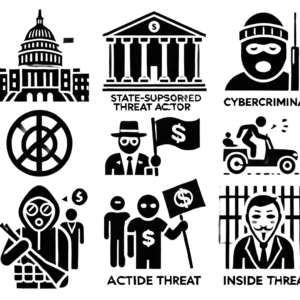Defining Cyber Threat Actors
When delving into the realm of cybersecurity, understanding the various types of cyber threat actors becomes paramount in fortifying defenses against potential attacks. Cyber threat actors encompass a diverse array of individuals or groups with distinct motivations and skill sets, each posing unique challenges to an organization’s security posture. These threat actors can be categorized into different groups based on their intent, expertise, and objectives.
Some common types of cyber threat actors are groups that work for governments, cybercriminals, activists who hack for causes, and people who work within a company to breach security. State-sponsored threat actors work on behalf of governments to gather secret information or disrupt other countries. Cybercriminals are mainly interested in making money and may steal financial information, hold data for ransom, or sell stolen information online.
Hacktivists leverage cyber attacks as a means of activism, aiming to promote a social or political agenda by disrupting services or stealing sensitive information. Insider threats, on the contrary, pose a threat from within the organization, as disgruntled employees or contractors may misuse their access for personal gain or to harm the company.
By comprehensively understanding the distinct characteristics and motivations of various cyber threat actors, organizations can implement targeted security measures and proactive strategies to mitigate potential risks and safeguard their digital assets.
Importance of Understanding Cyber Threat Actors
Understanding cyber criminals is important in the field of cybersecurity because it helps organizations protect themselves from potential attacks. By knowing the different types of cyber criminals and their reasons for attacking, businesses can better defend their sensitive information and networks.
There are different categories of cyber threat actors, including nation-state actors, cybercriminals, hacktivists, and insiders. Each category has unique objectives and techniques, from stealing data for financial gain to disrupting operations for political agendas. By identifying these actors and their motivations, organizations can tailor their security measures to mitigate specific risks.
Moreover, understanding cyber threat actors can help anticipate future threats and stay ahead of emerging trends in the cybersecurity landscape. By monitoring the behaviors and tactics of threat actors, organizations can enhance their threat intelligence capabilities and develop proactive defenses to counter potential attacks.
In summary, understanding who cyber criminals are is important for any organization wanting to improve its online security and keep its important information safe from new online dangers.
Types of Cyber Threat Actors
State-sponsored Actors
State-sponsored actors are among the most sophisticated and dangerous cyber threat actors operating in the digital landscape today. These threat actors, often backed by government entities, possess advanced technical capabilities and resources, enabling them to carry out highly complex and targeted cyber attacks on a global scale. Motivated by political, economic, or military objectives, state-sponsored actors engage in cyber espionage, sabotage, and influence campaigns to further their agendas and gain strategic advantages.
Unlike other types of threat actors, state-sponsored actors have access to significant funding, top-tier talent, and advanced tools and technologies, making them formidable adversaries for organizations and governments alike. Their attacks are often characterized by their stealth, precision, and persistence, as they carefully plan and execute sophisticated cyber operations to achieve their goals while remaining undetected for long periods of time.
It is important to understand how governments use different methods and reasons to launch cyber attacks in order to come up with better ways to protect against them. By keeping up to date on these threats, organizations can keep their valuable information and important systems safe from potential breaches and attacks.
Organized Cybercriminals

Organized cybercriminals are a significant threat in the digital landscape, utilizing sophisticated tactics and strategies to carry out malicious activities for financial gain or other motives. These threat actors operate in well-structured groups with defined roles and responsibilities, often collaborating across borders to maximize their impact. Understanding the types and motivations of organized cybercriminals is crucial for cybersecurity professionals and organizations to effectively defend against their attacks.
Whether it’s an organized crime syndicate seeking monetary profits through activities like ransomware attacks or a state-sponsored group looking to espionage or disrupt critical infrastructure, the motivations of these cybercriminals vary widely. Some groups may focus on stealing sensitive data for selling on the dark web, while others may target specific industries or organizations for political reasons. By comprehending the mindset and objectives of organized cybercriminals, cybersecurity experts can better anticipate and thwart their malicious schemes.
As technology gets better, cybercriminals are also getting smarter. It’s important for businesses to keep up with the latest cybersecurity threats and be proactive in protecting against them. By staying informed and understanding why cybercriminals do what they do, companies can make their defenses stronger and reduce the risks of being attacked.
Hacktivists
In the realm of cybersecurity, hacktivists are a unique type of threat actor known for their use of hacking skills to promote social or political causes. Motivated by a desire to raise awareness or enact change, hacktivists often target organizations or individuals they view as opposing their beliefs. Common tactics employed by hacktivists include website defacement, distributed denial of service (DDoS) attacks, and data breaches. While their actions can sometimes expose vulnerabilities in systems, they also pose risks to data integrity and privacy. Understanding hacktivists’ motivations is crucial in developing effective strategies to mitigate their impact.
Motivations behind Cyber Threats
Political / Ideological Motives
When it comes to understanding cyber threat actors, political and ideological motives play a significant role in driving their actions. These threat actors are often individuals or groups with strong political beliefs or ideologies that they seek to promote or defend through their cyber activities. They may target government organizations, political parties, or influential individuals to sabotage or manipulate information for their own agenda.
Cyber attacks driven by political or ideological motives can have far-reaching consequences, impacting not only the targeted entities but also the broader socio-political landscape. Such attacks can disrupt critical infrastructure, compromise sensitive data, and even influence election outcomes, posing a serious threat to national security and democratic processes.
Understanding the motivations behind these cyber threat actors is crucial for cybersecurity professionals and policymakers to develop effective defense strategies. By analyzing the political and ideological factors driving these attacks, organizations can better anticipate and mitigate potential threats, safeguarding against potentially devastating cyber incidents.
Financial Gain
One of the main reasons cybercriminals do what they do is to make money. These bad actors target financial institutions, companies, or even regular people to steal important financial information like credit card numbers, online banking logins, or personal details. With this information, cybercriminals can do things like steal your identity, make unauthorized purchases with your credit card, or even try to clean their dirty money. Sometimes these cybercriminals will also try to hold your files ransom by encrypting them and demanding money in exchange for the code to unlock them.
In addition, hackers can make money by selling stolen information on the hidden parts of the internet to other bad guys. They might also use your computer to mine cryptocurrency or send fake emails to try and steal your money. These cybercriminals are always changing their methods to get around security measures and make as much money as possible.
Reputation and Infamy
When looking at cybercriminals, it’s important to understand why they do what they do so we can protect ourselves better. Some hackers want to be seen as cool in online groups, so they do big attacks to get attention. Others just like causing chaos and getting noticed. By learning about these different types of hackers and why they do what they do, we can be more prepared to defend against cyber attacks. We need to always be on the lookout and update our defenses to stay safe.
How to Protect Against Different Cyber Threat Actors
Secure Infrastructure and Systems
In today’s digital landscape, understanding cyber threat actors, their types, and motivations is crucial to maintaining a secure infrastructure and systems. Cyber threat actors can range from nation-states and organized crime groups to hacktivists and individual hackers, each with their own unique objectives and tactics.
Nation-state actors are often motivated by political, economic, or espionage goals, using advanced techniques to penetrate targets and steal sensitive information. Meanwhile, organized crime groups focus on financial gain through activities such as ransomware attacks and banking fraud. Hacktivists, on the other hand, aim to promote a social or political agenda by disrupting operations and causing reputational damage.
Understanding the motivations behind these threat actors allows organizations to better defend against potential attacks. By implementing robust cybersecurity measures, such as regular security assessments, employee training, and strong access controls, businesses can fortify their infrastructure against a wide range of threats.
Ultimately, by staying informed about cyber threat actors and their tactics, organizations can proactively protect their systems and data from malicious actors seeking to exploit vulnerabilities.
Education and Training
When it comes to knowing about cyber threat actors, education and training are really important. They help individuals and organizations learn the skills needed to protect themselves from cyber attacks. Cyber threat actors can be hackers, groups supported by governments, cybercriminals, or even people working within a company. Each of these types has their own reasons for hacking and ways of doing it. By taking part in education and training programs, people in the cybersecurity field can keep up with the newest methods used by cyber attackers.
Training programs often cover topics such as ethical hacking, penetration testing, incident response, and threat intelligence, providing learners with hands-on experience in identifying vulnerabilities and mitigating attacks. Moreover, understanding the motivations behind cyber threats is essential for implementing effective security measures and developing robust defense strategies.
By learning more about cybersecurity and staying up-to-date on the latest trends, people can improve their online safety and help prevent cyber attacks. Similarly, businesses can stay safe by staying informed and taking steps to protect their important information from potential hackers.
Key Takeaways
To protect against cyber attacks, it’s important for organizations to understand why and how attackers target them. By knowing this information, companies can create strong defenses to stop potential attacks. It’s crucial to have strong security measures in place, regularly check for threats, train employees on cybersecurity, and have a plan in case of an incident. Working together with other companies, sharing information on threats, and staying up-to-date on the latest cyber threats are also important ways to stay safe from cyber attacks.
